If the pka of a drug i Study guides, Class notes & Summaries
Looking for the best study guides, study notes and summaries about If the pka of a drug i? On this page you'll find 76 study documents about If the pka of a drug i.
Page 4 out of 76 results
Sort by
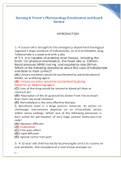
-
Katzung & Trevor's Pharmacology: Examination and Board Review Latest solution
- Exam (elaborations) • 112 pages • 2023
-
- $17.49
- + learn more
Katzung & Trevor's Pharmacology: Examination and Board Review INTRODUCTION 1. A 3-year-old is brought to the emergency department having just ingested a large overdose of tolbutamide, an oral antidiabetic drug. Tolbutamide is a weak acid with a pKa of 5.3. It is capable of entering most tissues, including the brain. On physical examination, the heart rate is 100/min, blood pressure 90/50 mm Hg, and respiratory rate 20/min. Which of the following statements about this case of tolb...
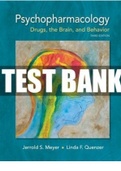
-
Psychopharmacology Drugs the Brain and Behavior 3rd Edition Meyer Nursing Test Bank
- Exam (elaborations) • 248 pages • 2023
-
- $11.49
- + learn more
1. refer(s) to specific molecular changes that occur when a drug binds to a particular target site or receptor, while are the resulting widespread alterations in function. a. Drug action; therapeutic effects b. Side effects; drug effects c. Therapeutic effects; side effects d. Drug action; drug effects Answer: d Textbook Reference: Pharmacology: The Science of Drug Action Psychopharmacology Drugs the Brain and Behavior 3rd Edition Meyer Nursing Test Bank | Complete Guide A+ Page 1 of 247 Test Ba...
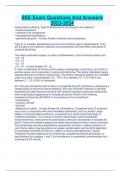
-
SEE Exam Questions And Answers 2023-2024
- Exam (elaborations) • 84 pages • 2023
-
- $18.49
- + learn more
SEE Exam Questions And Answers 2023-2024 During fetal monitoring, Type III decelerations are thought to be related to: • head compression • umbilical cord compression • uteroplacental insufficiency • placental abruption - Correct Answer-umbilical cord compression Type III, or variable, decelerations are the most common type of decelerations. They are thought to be related to umbilical cord compression and intermittent decreases in umbilical blood flow. The arteria radiculari...

-
Pharmacology Mental Dental| 204 QUESTION| WITH COMPLETE SOLUTIONS
- Exam (elaborations) • 29 pages • 2022
-
- $10.49
- + learn more
Amides are metabolized by Correct Answer: Liver Correct Answer: Esters are metabolized by: Correct Answer: Pseudocholinesterase in Plasma What are the esters: aine Correct Answer: Procaine Cocaine Tetracaine Benzocaine What amide is safest in children? Correct Answer: Lidocaine (Xylocaine) What amide is NOT safe in children and has longest duration of action? Correct Answer: Bupivicaine (Marcaine)- longest duration What amide causes the lease amount of vasodilation? ...
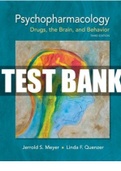
-
Psychopharmacology Drugs the Brain and Behavior 3rd Edition Meyer Nursing Test Bank
- Exam (elaborations) • 248 pages • 2021
-
- $17.99
- 15x sold
- + learn more
WWW.THENURSINGMASTERY.COM Page 1 of 247 Test Bank to accompany Psychopharmacology, Third Edition Meyer • Quenzer Chapter 1: Principles of Pharmacology Multiple Choice 1. refer(s) to specific molecular changes that occur when a drug binds to a particular target site or receptor, while are the resulting widespread alterations in function. a. Drug action; therapeutic effects b. Side effects; drug effects c. Therapeutic effects; side effects d. Drug action; drug effects Answer: d T...

-
Psychopharmacology Drugs the Brain and Behavior 3rd Edition Meyer Test Bank
- Exam (elaborations) • 253 pages • 2022
-
- $14.14
- + learn more
Psychopharmacology Drugs The Brain And Behavior 3rd Edition Meyer Nursing Test Bank Multiple Choice 1. refer(s) to specific molecular changes that occur when a drug binds to a particular target site or receptor, while are the resulting widespread alterationsin function. a. Drug action; therapeutic effects b. Side effects; drug effects c. Therapeutic effects; side effects d. Drug action; drug effects Answer: d Textbook Reference: Pharmacology: The Science of Drug Action 2. After drug administrati...
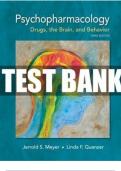
-
Psychopharmacology Drugs the Brain and Behavior 3rd Edition Meyer Nursing Test Bank
- Exam (elaborations) • 248 pages • 2023
-
- $11.49
- + learn more
1. refer(s) to specific molecular changes that occur when a drug binds to a particular target site or receptor, while are the resulting widespread alterations in function. a. Drug action; therapeutic effects b. Side effects; drug effects c. Therapeutic effects; side effects d. Drug action; drug effects Answer: d Textbook Reference: Pharmacology: The Science of Drug Action Psychopharmacology Drugs the Brain and Behavior 3rd Edition Meyer Nursing Test Bank | Complete Guide A+ Page 1 of 247 Test Ba...
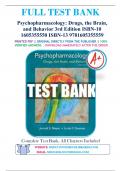
-
Test Bank for Psychopharmacology: Drugs, the Brain, and Behavior 3rd Edition by Jerrold S. Meyer & Linda F. Quenzer ISBN 9781605355559 Chapter 1-20 | Complete Guide A+
- Exam (elaborations) • 248 pages • 2022
-
- $19.99
- + learn more
Psychopharmacology Drugs The Brain And Behavior 3rd Edition Meyer Nursing Test Bank Multiple Choice 1. refer(s) to specific molecular changes that occur when a drug binds to a particular target site or receptor, while are the resulting widespread alterationsin function. a. Drug action; therapeutic effects b. Side effects; drug effects c. Therapeutic effects; side effects d. Drug action; drug effects Answer: d Textbook Reference: Pharmacology: The Science of Drug Action 2. After drug administrati...

-
Comprehensive CRNA Interview Review Reliable in preparing for Exams
- Presentation • 70 pages • 2023
-
- $14.49
- + learn more
Comprehensive CRNA Interview Review Comprehensive CRNA Interview Review Reliable in preparing for Exams Comprehensive CRNA Interview Review Norepinephrine Mechanism of Action (MOA) A1, A2, B1 agonist. Primary agent used in distributive shock because it's ability to recruit venous volume and augment preload, while increasing arterial tone, and increasing cardiac output. Alpha one causing peripheral smooth muscle contraction. (low dose venous, high dose venous and arterial). Alpha...
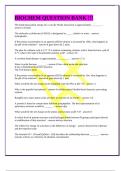
-
biochem question bank !!!
- Exam (elaborations) • 18 pages • 2024
-
- $11.49
- + learn more
The bond dissociation energy for a van der Waals interaction is approximately ________. - answer-2 kJ/mol The molecule cyclohexane (C6H12) is designated as _____ relative to water. - answer-hydrophobic If the proton concentration in an aqueous (H2O) solution is increased by 100x, what happens to the pH of the solution? - answer-It goes down by 2 units. The pKa for carbonic acid is 3.77. If a solution containing carbonic acid is found to have a pH of 4.77, what is the ratio of bicarbonat...

Did you know that on average a seller on Stuvia earns $82 per month selling study resources? Hmm, hint, hint. Discover all about earning on Stuvia


